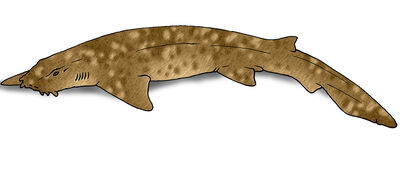
Artist's description of creature.
Ground Shark is an unknown fish, reported from Timor Sea. Larger than a great white shark, which has an average length of 14 feet. No prominent dorsal fin. Lies in wait for other fishes on the ocean floor. Said to be a man-eater.
According to the Timorese, the waters of the Timor Sea are home to not one, but two kinds of large, man eating shark. The first is well known, the great white shark, but the second is apparently unrecorded by science. Referred to as the “ground shark”, it lacks a dorsal fin, and lies in wait on the ocean floor, it is said to be even bigger than a great white.
It has been suggested that this huge, bottom dwelling shark might actually be an exceedingly large kind of wobbegong, a shark well known for laying camouflaged on the sea floor. Descriptions of the Timor ground shark do not mention a cryptic colour pattern, or the characteristic facial tassels of the wobbegong, and wobbegongs very seldom attack humans. The idea of a huge, undiscovered shark in such shallow, well traversed waters is relatively unlikely, and it is possible that the ground shark is simply a “sea monster” myth, or a folkloric exaggeration of typical bottom dwelling sharks. The truth of the matter has not been resolved, and possibly never will.
We generally agree that a gigantic wobbegong would make a suitable sea monster, so our speculation concurs. The Timor Ground Shark (Megaorectolobus fatalis) is the largest and most dangerous kind of wobbegong, reaching 6 metres long. Despite its name, it can be found in the Java, Bali, Celebes and Flores Seas, as well as the Timor Sea. Unlike other large sharks it is a bottom dweller, sitting camouflaged on the ocean floor to ambush fish, crustaceans, and octopi of fairly large size, prey is swallowed whole. This shark can occasionally be a man eater, seizing unwary divers in its large mouth, lined with long conical teeth. Being ovoviparous, they give birth to 3 or 4 well-developed pups that are able to fend for themselves. Unlike most wobbegongs, its facial tassels are small and unobtrusive, serving a sensory role more so than camouflage. It has a low metabolism and can go a week without feeding, if necessary.
Possible explanation[]
- A giant form of Wobbegong shark (Family Orectolobidae), suggested by Karl Shuker. The Spotted wobbegong (Orectolobus maculatus) inhabits Australasian waters and grows to 10 feet 6 inches. It feeds on the bottom but attacks waders and fishers in tidal pools.